lead story
“India Offers Enhanced Defence Partnership to Friendly Countries”


Rajnath Singh hosts Defence Ministers’ Conclave on the sidelines of Aero India 2023, calls for greater cooperation to deal with fast-paced changes in an increasingly complex global security scenario

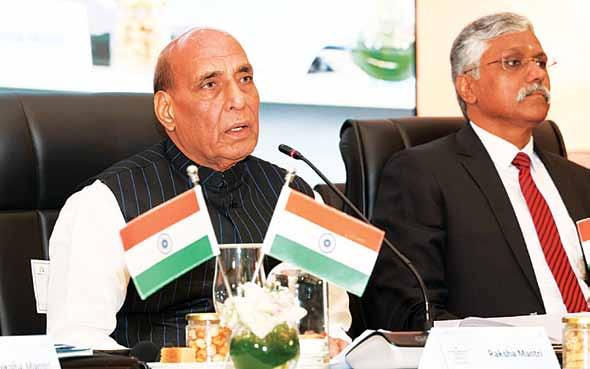
Defence Minister Rajnath Singh hosted the Defence & Deputy Defence Ministers of 27 countries at the Defence Ministers’ Conclave held on the sidelines of Aero India 2023 on February 14, 2023. The broad theme of the conclave was ‘Shared Prosperity through Enhanced Engagements in Defence’ (SPEED). It sought to address aspects related to deepening cooperation for capacity building (through investments, R&D, joint ventures, co-development, co-production and provisioning of defence equipment), training, space, AI and maritime security to grow together.
In his inaugural address, the Defence Minister highlighted the need for greater cooperation in an increasingly-complex global security scenario. He stated that the theme of the event ‘SPEED’ characterises the present era
wherein geopolitical and security realities are shifting at hitherto unwitnessed speed. He called for real-time collaboration to respond to such fast-paced changes.
Rajnath Singh was of the view that any major change in the domain of economy, security, health or climate has global reverberations and when peace and security of any region is threatened, the entire world feels its impact in multiple ways. He pointed out that in an interconnected and networked world, the rapid transmission of shocks and disturbances makes it impossible to insulate one’s own country from the issues of other countries. He emphasised on regular interactions during summits, conferences and conclaves to ensure that concerns of all are suitably addressed for a common, secure and prosperous future.
WWW.SPSShoWneWS COM 1 | Day 3 | febraury 15, 2023 DAY 3 Wednesday February 15, 2023
AN SP GUIDE PUBLICATION See US at Hall – C Stall N0. CS1.13 SP’s ExclusivE intErviEw: Air chiEf MArshAl v.r. chAudhAri, chiEf of thE Air stAff, indiAn Air forcE 4 futurE of AEriAl wArfArE — JournEy froM PlAtforMs MindsEt to cAPAbilitiEs MindsEt 6 intErviEw: AlAin GArciA, vicE PrEsidEnt, indiA businEss dEvEloPMEnt, boEinG dEfEnsE, sPAcE & sEcurity 7 intErviEw: bhAnu PrAkAsh srivAstAvA, chAirMAn & MAnAGinG dirEctor, bhArAt ElEctronics ltd 8 MAnufActurinG cuttinG-EdGE Products nEEd of thE hour 9 Growth in indiAn PAssEnGEr trAffic 10 sAAb’s idAs: sElf-ProtEction systEM of choicE 10
P ublish E rs of SP’S MILItaRy yEaRBOOk,
ShowNewS
INSIDE
SP’S cIvIL avIatIOn yEaRBOOk, SP’S avIatIOn, SP’S aIRBUZ, SP’S Land FORcES, SP’S navaL FORcES, SP’S M.a.I. & BIZavIndIa
Defence Minister rajnath singh aDDressing the Defence & Deputy Defence Ministers of 27 countries at the Defence Ministers’ conclave
historic debut oF F-35
us air force’s newest fifthgeneration fighters – the f-35a lightning ii anD f-35a joint strike fighter are here for the first tiMe to take part in aero inDia-2023
In the event of a disaster, armed conflict or other similar challenges, fast and secure communication is key. But what if the communication infrastructure is destroyed, limited or non-existent? How to ensure you can act at full speed?
Speed as in rapid deployment of your own broadband network. Speed as in complete setup within minutes. Speed as in bandwidth that allows for transfer of large amounts of speech, data and video.
The answer is DeployNet – a scalable, ruggedised, compact 5G/ LTE network solution with fast access to cyber secured high-speed connectivity – wherever you are, whenever you need it
Learn more at saab.com
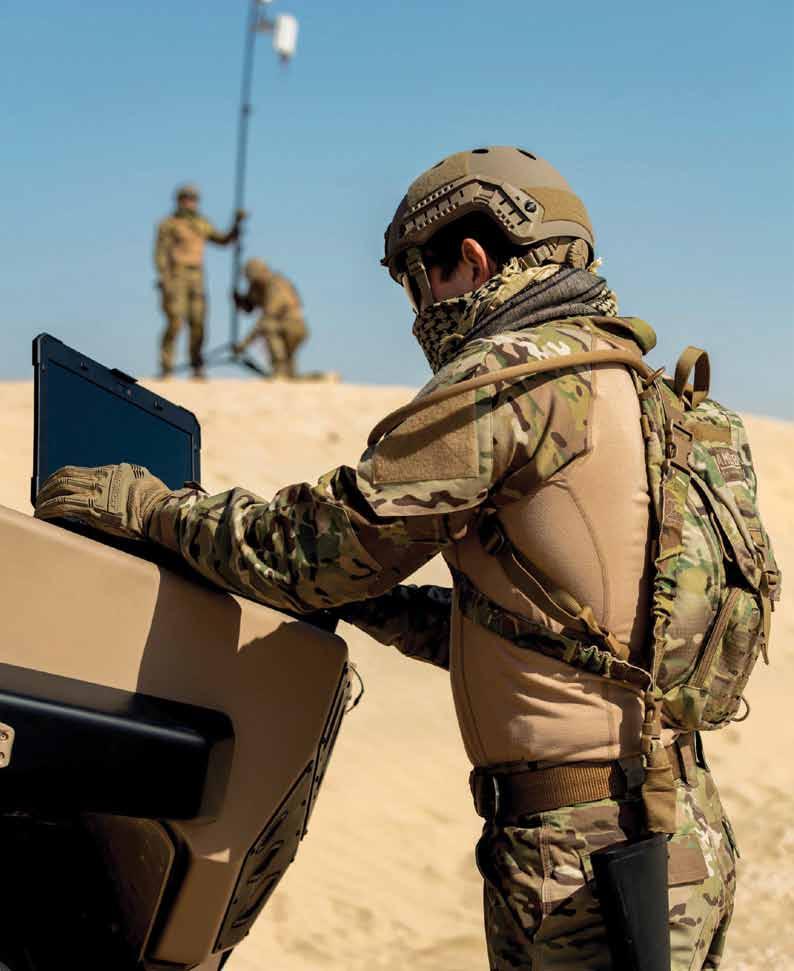
DEPLOYNET
is everything Secure Mission Critical 5G Network-On-Demand
Speed
The Defence Minister reaffirmed India’s stand for a rules-based international order, in which “the primordial instinct of the might being right is replaced by the civilisational concept of fairness, cooperation, respect and equality amongst all sovereign nations”. He asserted that untethered to any faction or alliance of one group of nations against another, India has worked ceaselessly for the upliftment of all nations, especially developing ones.
“India has always been open to new ideas from across the world, Commingling and contest of various thoughts has made us a global ideation centre. Our ancient ethos guides us to work not only towards cooperation for mutual benefit, but goes a welcome step further from a mere transactional approach to an edifying recognition of all humanity as one family,” Rajnath Singh said. He referred to the global efforts to deal with COVID-19 and said the pandemic underscored the point that shared global prosperity requires greater coordination among all nations in diverse areas, of which defence and security is one of the most important.
The Defence Minister described collective security as sine qua non (essential condition) for development and prosperity. He emphasised that terrorism, illegal arms trade, drugs smuggling, human trafficking, etc pose significant security threats to the world. He stressed on the need to devise new strategies to counter these threats. “India does not believe in dealing with such security issues in the old paternalistic or the neo-colonial paradigms. We consider all nations as equal partners. That is why, we do not believe in imposing external or supra national solutions to a country’s internal problems. We do not believe in giving sermons or cut-and-dried solutions, which do not respect the national values and constraints of the countries in need of assistance. Rather, we support the capacity building of our partner countries, so that they may chart out their own destiny, in accordance with their own genius,” he said.
Rajnath Singh added that there are nations which are richer, militarily or technologically more advanced than others, but it does not give them the right to dictate their solutions to the nations in need of support. This top-down approach towards solving problems has never been sustainable in the long run and it often leads to debt trap, reaction from the local population, conflict and so on, he said. He emphasised that the focus should be on providing assistance, in terms of building of institutions and capacities, so that bottom-up solutions can come up organically, in consonance with the ethos of the nations being assisted.
He informed the Defence Ministers present that India is moving ahead working with this principle by offering enhanced defence partnership to its friendly countries. “We offer a partnership that is accommodative of the national priorities and capacities. We want to build with you, we want to launch with you, we want to create with you and we want to develop with you. We wish to create symbiotic relationships, where we can learn from each other, grow together and create a win-win situation for all,” he said, reiterating the Government’s endeavour to transcend hierarchical relationship of buyer and seller to a codevelopment and co-production model.
Rajnath Singh exuded confidence that through Aero India, the Defence Ministers would have gained knowledge about the robust defence manufacturing ecosystem being created in India. He urged them to share their requirements and expectations through enquiries, comments & feedback, which will provide the industry a significant learning opportunity.
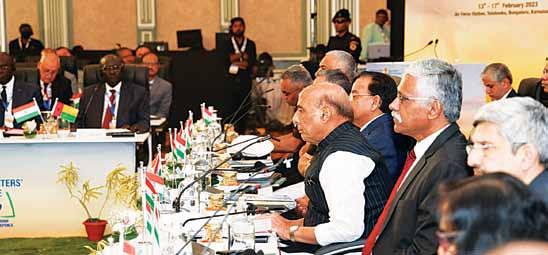
Over 160 delegates from several countries, including Defence & Deputy Defence Ministers from 27 countries, 15 Defence and Service Chiefs and 12 Permanent Secretaries from 80 countries participated in the conclave attesting to India’s tremendous growth and engagement in the defence and security sectors.
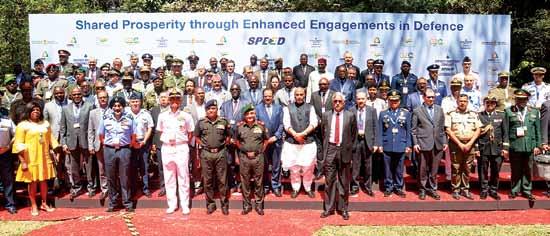
PUBLISHER and EdItoR-In-cHIEf
Jayant Baranwal
SEnIoR contRIBUtoRS
Lt General (Retd) P.C. Katoch
PRIncIPaL coRRESPondEnt
Ayushee Chaudhary
cHaIRMan & ManaGInG dIREctoR
Jayant Baranwal
PLannInG & BUSInESS dEvELoPMEnt
Executive Vice President: Rohit Goel
SaLES & MaRKEtInG
Group Director: Neetu Dhulia
Deputy Director - Sales: Rajeev Chugh
LaYoUt dESIGnERS
Sr Designer: Vimlesh Kumar Yadav Designer: Sonu S. Bisht
GRoUP RESEaRcH aSSocIatE Survi Massey
ManaGER - HR & adMIn
Bharti Sharma
dEPUtY ManaGER – cIRcULatIon
Rimpy Nischal
SP’S WEBSItES
Sr Web Developer: Shailendra Prakash Ashish
Web Developer: Ugrashen Vishwakarma
SP GUIdE PUBLIcatIonS Pvt Ltd
A-133, Arjun Nagar, (Opposite Defence Colony) New Delhi 110003, India
Tel: +91 (11) 24644693, 24644763, 24658322
Fax: +91 (11) 24647093
E-mail: info@spguidepublications.com
Owned, published and printed by Jayant Baranwal on behalf of SP Guide Publications Pvt Ltd. All rights reserved. No part of this publication may be reproduced, stored in a retrieval system, or transmitted in any form or by any means, photocopying, recording, electronic, or otherwise without prior written permission of the Publishers.
Printed at Kala Jyothi Process Pvt Ltd, Hyderabad
© SP Guide Publications, 2023
www.spguidepublications.com
for advertisement / Editorial queries, please contact us at Hall-c, Stall-cS1.13
PHOTOGRAPHS: SP Guide Publications (Archive), PIB, respective OEMs and miscellaneous
WWW.SPSShoWneWS COM aERO Ind I a 2023 3 | Day 3 | febraury 15, 2023 lead story
Defence Minister rajnath singh hosteD the Defence & Deputy Defence Ministers of 27 countries at the Defence Ministers’ conclave on the siDelines of aero inDia 2023
In this third and final part of an exclusive interview to Jayant Baranwal, Editor-in-Chief, SP’s ShowNews on the occasion of Aero India 2023, Air Chief Marshal V.R. Chaudhari, Chief of the Air Staff, gave some very elaborate and candid insights on the plans and preparedness of the Indian Air Force
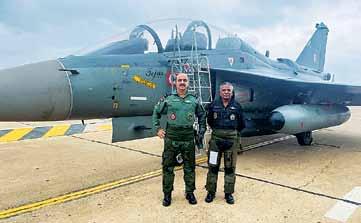

SP’s ShowNews (SP’s): Electronic Warfare (EW)
(a): What capabilities IAF should be possessing in view of the perceived threat scenarios?
Chief of the Air Staff (CAS): EW systems endow an enhanced layer of protection to weapon platforms, while also denuding the adversary aircraft of the same. Consequently, there is a need to equip all aircraft with EW self-protection systems like Radar Warning Receivers, Airborne Self Protection Jammers (ASPJs), Missile approach and warning systems and Laser Warning Systems. Whilst some transport and helicopters do possess some capability, there are others which need to be provided with additional protection. Such self-protection measures also need to be complimented with an offensive EW capability. This could be in the form of a transport aircraft jamming from stand-off distances or light weight jammers on Remotely piloted aircraft (RPA). Other avenues that we are looking at include high power Directed Energy Weapons and multipurpose ground based jammers.
(b): And how do you perceive the current state of affairs?
CAS: The IAF’s has equipment of diverse origins, thus having varying philosophies of employment. This has given us an interesting insight into the employment of Electromagnetic Counter Measure techniques by different countries. By now we are also very familiar with the EW methodologies and systems operated by our adversaries. We have thus been able to refine our techniques and develop cogent responses. Work is in progress to equip our platforms with the latest EW systems, while existing deficiencies are being addressed in tandem. But this is a cat & mouse game, wherein continuous refinements are necessitated and that is what we endeavour to do.
SP’s: Please enlighten us in terms of the IT-based protection capabilities if you are duly satisfied with the current level of systems in place.
CAS: As the IAF’s operations become more net centric and our offices more paperless, there is a need for us to enhance the protection of our IT assets. We have therefore undertaken a slew of measures in this regard. For instance, multilayered security solutions and security management systems are now in place to defend our Net Centric Warfare infrastructure. A dedicated Security Operation Centre (SOC) has also been setup with a dedicated Security Information and Event Management System where real time threats are monitored. The Computer Emergency Response Team of the IAF in turn, responds to these threats. A separate Internet Security Operation Centre (iSOC) has also been setup for ensuring the security of our internet machines. A dedicated Air Force Cyber Group oversees these functions, while air warriors are trained in our Information Warfare School which has been set up to enhance cyber education and cyber security awareness among our personnel.
SP’s: Countering Cyberattacks. Would you like to share what sort of eventualities/threat scenarios need to be kept in mind while planning and executing the necessary firewalls enabling fool-proof solutions?
CAS: Key to our Cyber security is redundancy and defensive depth that adopts a layered approach to protect our data and information. Our endeavour is that in case of failure of one mechanism, another should step in immediately to foil
an attack. This multi-layered approach enhances the security of our systems as a whole and is able to thwart different attack vectors. However, we have to be very nimble, adaptive and flexible by continually upgrading our infrastructure and procedures. We have to thus employ a combination of security products such as next generation firewalls, network segmentation, malware scanners, endpoint security, Patch management etc.
SP’s: Self-reliant Aerospace and Defence industry
(a): How do you perceive the R&D efforts being made in the country as this remains the foundation of achieving self-reliance in the aerospace and defence industry.
CAS: IAF has always supported the national vision of ‘Atmanirbhar Bharat’ and IAF was at the forefront of indigenisation efforts. In the last few years, IAF has inducted various aircraft, radars and airborne platforms developed within the country. The induction of LCA (Tejas), Aslesha Radars, Astra Air-Air Missile, Akash Surface to Air Missile, Advanced Light Helicopter (ALH), Integrated Air Command & Control System (IACCS) and Light Combat Helicopter (LCH) are a testimony of IAF’s commitment to the national vision of Atmanirbhar Bharat.
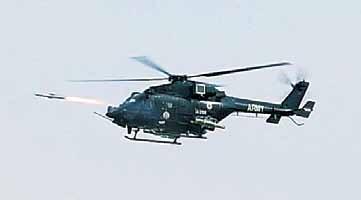
Since 2016, the Government has ensured that the most preferred option for capital acquisition is to buy Indigenously Designed Developed and Manufactured (IDDM) category equipment, followed by the Buy (Indian) category. Also, to enhance the participation of Indian private industries in the field of defence manufacturing and production, the Government has introduced various initiatives under the Make in India scheme. We have subscribed to each of these schemes and have fielded several cases through Make I, II & III schemes. Furthermore, the IAF is also providing necessary support to the Startups engaged in iDEX by providing test facilities and guidance during the design and development stage of the projects. Additionally, we are also pursuing 20 projects under Technology Development Fund (TDF) scheme. As Indian industry gets more and more involved in these IAF projects, it is but natural that their own competencies will also grow and trickle down to tertiary levels over a period of time.
(b): Although some key programmes are being developed and progressing further as Made in India such as LCA, LCH, how do you find the pace of delivery schedules? How do you find their combat worthiness?
CAS: There have been some issues with the delivery schedules during the last few years. However, the DPSUs have matured in terms of size, scale and technology, making them more capable. Accordingly, we are hopeful that programme delays will be resolved in the near future.
Of the two indigenous products that you mentioned, I would like to stress that the LCA is superior to contemporary aircraft of similar class available with our adversaries. To add to its capability, the long range Beyond Visual Range (BVR) indigenous ASTRA missile is being integrated, as are other long range standoff weapons. Likewise, the LCH has already been integrated with 70mm rockets and Air to Air Missile, thus making it a potent platform. Trials on the indigenously developed Dhruvastra for the Advanced Light Helicopter (ALH) Mk IV have also been completed with successful firing having been conducted in May 22. The procurement case is currently being progressed with DRDL.
aERO Ind I a 2023 WWW.SPSShoWneWS COM www.spguidepublications.com 4 | Day 3 | febraury 15, 2023 exclusive interview cas
“IAF has always supported the national vision of ‘Atmanirbhar Bharat’ and IAF was at the forefront of indigenisation efforts”
(top) light coMbat aircraft (lca) tejas; (above) anti-tank guiDeD Missile systeMs ‘helina’.






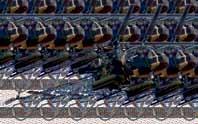












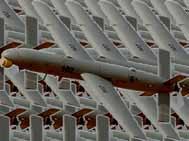
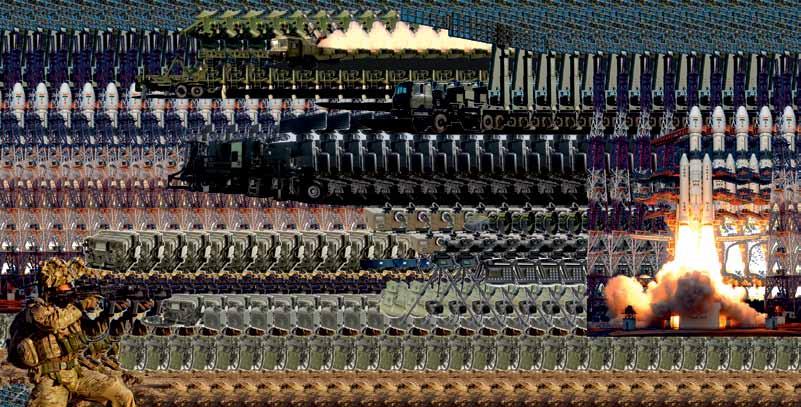
MILDS MILDS MILDS MILDS MILDS MILDS
Future of Aerial Warfare — Journey from Platforms Mindset to Capabilities Mindset

One major component of futuristic warfare is the increasing use of unmanned aerial vehicles (UAVs) for ISR and a wide range of more strategic and critical roles, including air-to-ground strikes and electronic warfare
Aerial warfare refers to the use of military aircraft and other air-based platforms in warfare including bombers, gliders, helicopters as well as military transport aircraft. However, today the entire ecosystem has evolved towards unmanned platforms. In yesteryears, the number of aircraft and other platforms had a large significance. Today, there is a lot of focus on acquiring capabilities that can enhance multi-fold the efficiency of the same number of platforms. Almost all countries today are looking at leveraging technology to the maximum within the limited budget boundaries. The future of aerial warfare is hence likely to be shaped and sliced through exponential advances in technology in this decade and in times to come. These changes are organic i.e. as a natural evolution, as well as are also driven by changes in the global political and security environment i.e. being fast tracked to meet futuristic demand.
One major component of futuristic warfare is the increasing use of unmanned aerial vehicles (UAVs). What arguably started as a platform to be leveraged for reconnaissance and surveillance, UAVs are now developed for a wide range of more strategic and critical roles, including air-to-ground strikes and electronic warfare. Seen as a cost-effective way of carrying out military operations due to the remote operational capability, the life of a soldier is the clear benefit. Today, there are enough and more companies in India itself who work towards innovations
cation, stealth is a function of multiple variables including materials, metallurgy, machining and airframe structure. DRDO has been working on developing stealth technology including development of radar absorbent materials and shaping techniques that can reduce an aircraft’s radar cross-section. More recently, DRDO also developed an advanced composite material for the airframe of the AMCA, which is India’s fifth generation stealth, multi-role air superiority fighter aircraft currently being planned for advanced design and prototype development in the near future.
While fighter aircraft, missiles and UAVs are parallelly being designed, developed and manufactured, an important element for all aerial platforms is aero engines. For India, aero engines have unanimously been called out as a major lacunae and multiple options are currently being evaluated and deliberated towards. Having an indigenous ecosystem for aero engine development across the entire spectrum of small engines for UAVs and missiles as well as large engines for fighter and transport aircraft, is an immediate priority area. All relevant stakeholders including public and private entities are making efforts towards having the desired capabilities and capacities for aero engines. India’s aerial warfare is significantly dependent on engines availability and supply chain shocks due to various factors can make a huge dent in defence preparedness. Hence for India’s future of aerial warfare, engines are as critical a factor as any other. Advanced engines such as ‘Adaptive Versatile Engine
in the UAV segment. DRDO as the R&D wing of India’s defence ecosystem has demonstrated indigenous ability in carrying out missions with a fully operational decentralised swarm of 25 drones in assorted formations (drone swarms) wherein the drones are capable of distributive sensing and autonomous decision-making. Unmanned aerial vehicles today are gradually evolving into major deterrents as well as a major avenue for offensive operations. DRDO has also successfully demonstrated capabilities in stealth combat drone through the demonstrator called “Stealth Wing Flying Testbed”. The airframe, undercarriage and entire flight control and avionics systems have reportedly been indigenously developed. UAVs are no doubt a very critical component when it comes to the evolution of aerial warfare in the coming decades. The shape, form and impact may vary but fundamentally unmanned systems are the future.

Another important development that has lent a huge credibility to the potency of forces around the world as well as India is the development of hypersonic weapons. These are weapons that travel at speeds of more than 5x times the speed of sound evading most current air defence systems to a very large extent. They are seen as a potential game-changer in warfare and are hence being developed by a number of countries, including the US, Russia, and China. DRDO has also successfully demonstrated hypersonic air breathing scramjet technologies through its hypersonic technology demonstration vehicle (HSTDV) in 2020. Launched using an indigenously developed scramjet propulsion system, the vehicle achieved speed up to Mach 6. DRDO is also reportedly working on BrahMosII hypersonic anti-ship missile making it twice as fast as BrahMos-I with range reportedly going up to 1,000 kms.
UAVs along with hypersonic platforms and weapons when combined with stealth are a lethal combination. The development of stealth is therefore another gamechanging element that can prove decisive in futuristic aerial warfare. Stealth technology makes it difficult for sensors and radars to detect an aircraft thereby making it harder for enemy air defences to engage them. An immensely sophisticated appli-
Technology (ADVENT)’ can reportedly allow for longer ranges as well as higher performance by varying their by-pass ratios for optimum efficiency in flight as well. The ADVENT aircraft engine development programme being pursued in the US is reflective of technology advancements that are required even on legacy systems for them to be state of the art when it comes to aerial warfare.
While the above are references to the hard segments of aerial warfare, what is equally important are the soft aspects including Artificial Intelligence (AI), Blockchain and Machine Learning (ML). The future of aerial warfare will be equally impacted by the growing use of AI-ML as well. These technologies enable aircraft to make decisions and carry out actions autonomously, thereby increasing their effectiveness and reducing risk to pilots. AI-ML also help in analysing large amounts of data from sensors and cameras on aircraft thereby improving situational awareness and target identification. Blockchain, for its part is another critical development, wherein as one of its key application areas, the serviceability of aircraft can always be kept in check. Utilising predictive maintenance as a key catalyst, the spares availability and MRO schedule as well as planning for contingencies for aircraft can be very well enabled.
As the IAF continues its journey from being platform driven to being more capability-driven, network-centric operations will be key going forward. It is important that lessons are imbibed from the LCA programme and the Kaveri programme and it is ensured that the learning curve is steep enough to ensure 2x times capabilities in 0.5x time frame going forward. While the Russia-Ukraine war may allow for contradictions to the fact that future conflicts will largely be short, swift and decisive – the former is in all probability just an exception and not the rule. Hence for meeting a swift threat or challenge it is important to keep all deterrence as well as offensive capabilities well-oiled and as advanced as any other across the globe. R&D again plays a very important role and with DRDO as the flagbearer and with industry gathering steam, the coming 8-10 years are poised to be a huge watershed period for India in aerial warfare.
Aero Ind IA 2023 WWW.SPSShoWneWS COM www.spguidepublications.com 6 | Day 3 | febraury 15, 2023 SPECIAL FEATURE
(left) A model of AmCA the AdvAnCed medium CombAt AirCrAft; (right) tAPAS iS A mAle uAv with An oPerAting Altitude of 30,000 ft And A rAnge of 250 kmS
SP’s ShowNews (SP’s): How does F/A-18 compare with its rival Rafale-Marine Fighter and what makes the F/A-18 suitable for the Indian Navy?
Alain Garcia (Garcia): The F/A-18 Super Hornet Block III will be a transformative capability for the Indian Navy (IN), the way that the P-8I has been. With these aircraft, Super Hornet, the Indian Navy will get a proven, multi-role and carriercompatible fighter while benefiting from the investments, upgrades and knowledge that come from the US Navy’s extensive naval aviation ecosystem.
One of the main benefits of this is that the aircraft has the ability to fold its wings, allowing for better utilisation of deck space on the aircraft carrier. Boeing has conducted a thorough study and analysis that optimises the number of Super Hornets that can fit aboard INS Vikramaditya and INS Vikrant, as well as optimises the cyclic operations from those carriers leading to high sortie generation rates.
Boeing has also developed a capability specifically for the F/A-18 Super Hornet Block III that will allow for the faster movement of the aircraft between the flight deck and hangar deck without having to remove or modify any part of the aircraft. This capability is compatible with the current elevator/lift configuration aboard Indian aircraft carriers. Another important fact to note is that the two-seater carrier-compatible variant of the Super Hornet offers several unique advantages to the IN including flexibility, higher utilisation of the fleet, and the ability to embark on certain missions from the carrier that benefit from having the second crew member.
Additionally, two-seater F/A-18 Super Hornets can be used as trainers (ashore and on the carrier) and as fully capable fighters, operational from carrier and from land bases. Thus, IN will get tremendous flexibility and a higher asset utilisation rate due to the carrier-compatible variant of the two-seater variant of the F/A-18. The F/A-18 Super Hornet has a very attractive lifecycle cost too. It not only has an affordable acquisition cost, but it costs less per flight hour to operate than any other tactical aircraft in production in the US forces inventory. This is possible because the fighter is designed for ease of maintainability and offers impressive durability with the life of the airframe up to 10,000 hrs. Boeing’s sustainment programme – “By India, For India” – is built on the success of existing programmes that the company is executing for the Indian Air Force (IAF) and IN today. These programmes will enable us to develop select capabilities to sustain the Super Hornet out of India.
SP’s: With a strong impetus for self-reliance in the defence sector, what is Boeing’s “Atmanirbhar Bharat” Strategy for F/A-18 Super Hornet Block III?

Garcia: Boeing is invested in strengthening its Make in India initiatives, building on a successful track record of contributing to India’s indigenous aerospace and defence ecosystem. As part of this effort, Boeing anticipates $3.6 billion in economic impact on the Indian aerospace and defence industry over the next 10 years, with the F/A-18 Super Hornet as India’s next carrier-based fighter. The economic impact would be over and above Boeing’s current offset obligations and plans in the country.
The new plan builds on Boeing’s sourcing of $1 billion annually from 300+ suppliers on parts, assemblies and services from Indian suppliers. Boeing has added several new Micro, Small and Medium Enterprises (MSMEs) suppliers in support of our commitment to Atmanirbhar Bharat, and they account for over 25 per cent of our suppliers in India. The plan also envisages potential for additional manufacturing opportunities, including the F/A-18’s Outer Wing and Nose Barrel component manufacturing and assembly. Additionally, Boeing is reviewing several hundred other machined assemblies that could be placed with Indian suppliers. Boeing envisions working closely with industry and the US and Indian governments
to share technology and transfer work of the F/A-18 fighter jets in India, based on interest and business case. Boeing will also leverage investments made in the Boeing India Engineering & Technology Center (BIETC) and its talented pool of 4,500+ engineers and innovators in Bengaluru and Chennai to drive growth and innovation, and advance work in materials, manufacturing technologies and methods, and the “Digital World.” With the F/A-18, Boeing will continue to explore opportunities to bring FSDA-related advanced technologies to the Indian defence industry.
The diversity and strength of the Hornet Industry Team, comprising of General Electric, Northrop Grumman and Raytheon, has the potential to deliver significant benefits to the Indian industry. These industry leaders have proven their commitment to India by collaborating with Indian entities and delivering on Atmanirbhar Bharat objectives. The F/A-18 will enhance collaboration with the Indian industry by facilitating knowledge transfer and promoting autonomy in operating and maintaining India’s fleet of F/A-18 aircraft. Further, this knowledge transfer may also provide opportunities for India to support F/A18 fleets around the world through manufacturing and sustainment.
SP’s: How are you contributing to the capability or skill building to support the growth of the indigenous aerospace and defence sector?

Garcia: Our growing platform base with commercial and defence customers in India and our expanding supplier base make it imperative for Boeing to invest in, develop and nurture talent. Boeing’s skill development activities in India touch every stakeholder in the aviation and aerospace ecosystem. Through our skilling and up-skilling initiatives, Boeing is developing Indian MSMEs, and training hundreds of pilots, aircraft maintenance engineers, technicians, and frontline factory workers across India with partners like Air India, Tata, and MSMEs – Rossell Techsys, SASMOS, Jaivel and also other industrial partners like Indo MIM, Lakshmi Machine Works, Airworks and Wipro. These programs have skilled close to 4,000 frontline aerospace manufacturing workers and aircraft maintenance engineers. Boeing’s investment in supplier development, training, tooling and quality management has enabled Indian suppliers to engage in high-value, high-tech manufacturing of complex aerospace components and subsystems for India and for the world.
SP’s: Can you talk about your engineering centre in India and how is it helping in capacity building?
Garcia: The Boeing India Engineering & Technology Center (BIETC) in India is leveraging a talented pool of 4,500+ engineers and innovators across Bengaluru and Chennai to drive growth and innovation in aerospace. BIETC centre was formally established in 2016 and currently houses Boeing’s engineering, test, research and technology, information technology and digital analytics teams. These technologists undertake high-quality, advanced aerospace work and offer engineering expertise to Boeing’s defence, space, and commercial businesses, spanning engineering design of structures and systems, manufacturing support, developing systems to test our aircraft, and providing digital solutions to our airline customers. Cutting-edge R&D in traditional and emerging areas is performed at the centre, including next-generation airplane health management, environmentfriendly coatings, advanced networks and secure-communications where teams leverage new-age technologies such as Artificial Intelligence, Machine Learning, Internet-of-Things, Cloud, Model-Based Engineering, and Additive Manufacturing to enhance quality, safety, and productivity. Boeing is investing $200million in a new 43-acre state-of-the-art wholly-owned engineering and technology campus in Bengaluru. This will be Boeing’s largest facility of its kind outside the US.
WWW.SPSShoWneWS COM Aero Ind IA 2023 7 | Day 3 | febraury 15, 2023 INTERVIEW boEINg
f/A-18 SuPer hornet bloCk iii
“The F/A-18 will enhance collaboration with the Indian industry by facilitating knowledge transfer and promoting autonomy in operating and maintaining India’s fleet”
Alain Garcia, Vice President, India Business Development, Boeing Defense, Space & Security and Global Services elaborates the potential significant benefits that Hornet Industry Team can deliver to the Indian industry
AlAin gArCiA
A Diversified Growth
In addition to seeing a very good opportunity in Defence Exports, BEL, has been continuously exploring diversification into allied Defence and non-defence areas. In conversation with Bhanu Prakash Srivastava, Chairman and Managing Director, Bharat Electronics Ltd

SP’s ShowNews (SP’s): Please tell us about your participation in Aero India this year.
Bhanu Prakash Srivastava (Srivastava): Bharat Electronics Ltd (BEL) will showcase state-of-the-art products and systems spanning every domain of its business at the 14th edition of Aero India 2023. The products and systems to be on display have been clustered as ‘Communication’, ‘Electro-Optics and Laser’, ‘EW and Avionics’, ‘Homeland Security & Smart Cities’, ‘Medical Electronics’, ‘Naval Systems’, ‘Network Centric Systems’, ‘Radar and Fire Control Systems’, ‘Tank Electronics and Gun Upgrade’, ‘Weapon System’, and ‘Outdoor Display Products’. In addition, BEL will also showcase its R&D capabilities by launching/demonstrating some of its new products and technologies. The company has set up an Experience Centre at its stall to showcase its Voice Analysis Software and Augmented Reality/Virtual Reality for Universal Simulator.
The highlight of BEL’s outdoor display will be Weapon Locating Radar (mountain version), Akash Air Defence System, Ant-Radiation Decoy System, Surveillance Radar, Air Defence Fire Control Radar, Automatic Manpack SATCOM Terminal, Anti Drone System and Mobile Communication Terminal. The entire set of state-of-art equipment on offer will be a force multiplier for any Defence force and civilian requirements.
SP’s: Can you brief us about BEL’s financial performance; what has been the impact of the pandemic on your growth?
Srivastava: BEL continues to be a profitmaking PSU, despite challenges posed by the pandemic, global chip shortage and stiff competition. FY 2021-22 saw the company registering a record turnover of `15,044 crores, a growth of nine per cent over the previous year. BEL became the first Defence PSU to cross the landmark market capitalisation figure of `80,000 crore, and declare the highest ever dividend of 450 per cent. The company has increased its authorised capital three-fold to `750 crore and issued bonus shares in the ratio 2:1. This year, we are confident of continuing the good show and achieve a revenue growth of 15 per cent and EBIDTA Margin of 21-23 per cent.
On this occasion, I would like to share with you the good news that the Ghaziabad Unit of BEL has won the twin honour of CII EXIM Bank Business Excellence Award (2022) and the Jury’s Commendation for Role Model Organisation. The Award is the highest level of recognition in the CII-EXIM Bank Award for Business Excellence.
SP’s: Please tell us about BEL’s exports. What are the major products and who are the customers?
Srivastava: BEL achieved recorded an Export turnover of $33.30 million during FY 2021-22. Major products exported included Coastal Surveillance System, Trans-Receive (TR) Modules, EO-IR Payload System, Compact Multi-Purpose Advanced Stabilization System (EOS CoMPASS), Solar Hybrid Power Plant, Data Link, Electro-Mechanical parts, Low Band Receivers (LBREC), Medical Electronics, Spares for Radars, etc.
BEL is fast expanding its global presence, putting its best foot forward to give a thrust to exports worldwide. All-out efforts are being made to tap new markets across the globe, including the Indian Ocean Region (IOR) and friendly foreign countries (FFCs).
The Government is encouraging defence exports through many policy initiatives and has set a target of `35,000 crore by 2025. BEL has identified Exports & Offsets as one of its thrust areas and has drawn up plans to offer its select products and systems to various export markets.

Some of the other products and systems which are being promoted for exports include Homeland Security solutions, Smart City solutions, Border Protection Systems and Coastal Surveillance System. Having established a Coastal
Surveillance System (CSS) for a few neighbouring countries, BEL is interacting with the Ministry of External Affairs for supply of CSS to other friendly countries. BEL is also focusing on Offset as a potential avenue for revenue generation. BEL is interacting with many foreign OEMs to meet Offset obligations in various programmes of the MoD. BEL has identified contract manufacturing (build-toprint and build-to-spec) for foreign OEMs and partnerships in the form of Transfer of Technology of the latest systems and solutions as areas of emerging export opportunities. Efforts are also on to establish long term supply chain relationship with global players.
SP’s: Tell us about your initiatives to diversify into the civilian business. Srivastava: Defence, being the mainstay of BEL, has traditionally been contributing to around 80 per cent of the Company’s annual sales revenue. BEL, however, has been continuously exploring opportunities in allied non-defence areas. The Company aims to increase its non-defence share in the overall business in the coming years.
Some of the areas BEL is focussing on in non-defence include solutions for Civil Aviation sector including Air Traffic Controller Radars, Anti Drone systems, Space/Satellite Electronics, Satellite Assembly & Integration, Unmanned Systems, Solar Business, Railway and Metro solutions, Software as a Service, Network & Cyber Security, Energy Storage products for Electric Vehicles (Li-ion & Fuel Cells, Charging Stations, etc), Homeland Security & Smart City businesses, Smart Meters, a range of Medical Electronic and health care solutions, Artificial Intelligence, Communication Radios & Networks, Composite Shelters & Masts, etc. This wide bouquet of businesses in nondefence would play a key role in driving BEL’s growth in the coming years.
SP’s: In recent years, the Government of India has stressed on the need to involve the MSMEs, private industry and startups in the Defence sector. What are BEL’s initiatives to promote such initiatives?
Srivastava: The Defence Sector is being opened up for private sector participation with the evolution of Defence Procurement Procedure. In this changing business scenario, BEL is focusing on enhancing interactions at various levels and building long-term relationships with customers, emerging Strategic Partners and other key stakeholders in the Indian Defence industry as a trusted and committed partner.
Be it the efforts that the Company has been putting in to engage in collaborative R&D in addition to augmenting its own R&D set up — its recent attempts to outsource work to Indian private industries and MSMEs, or the path breaking decision to go in for Public-Private partnerships to execute turnkey projects, BEL is leaving no stone unturned to ensure that it is in sync with the Government’s larger goal of indigenisation and self-reliance.
BEL has formulated a long-term Outsourcing and Vendor Development Policy and has been taking several initiatives in order to broaden the domestic vendor base by implementing online vendor registration and e-procurement processes including GeM. This is in line with the ‘Make in India’ initiative where enhanced thrust has to be put to develop domestic players. Make in India Display Cells have been established at all Units of BEL. The procurement from MSMEs by BEL has been over 20 per cent in the previous years. BEL also takes part in various events organised by the Government of India to promote MSMEs.
Startup India is a flagship initiative of the Government of India, intended to build a strong ecosystem that is conducive for the growth of startup businesses, to drive sustainable economic growth and generate large scale employment opportunities. BEL has identified several areas for partnership with startups in new emerging areas including Machine Learning, Cyber Security, Artificial Intelligence, Embedded Computing and other latest technologies which can be used for Defence electronics applications.
Aero Ind IA 2023 WWW.SPSShoWneWS COM www.spguidepublications.com 8 | Day 3 | febraury 15, 2023 INTERVIEW bEL
bhAnu PrAkASh SrivAStAvA
AkASh weAPon SyStem
Manufacturing Cutting-edge Products Need of the Hour to Attain ‘Atmanirbharta’: Defence

Minister Rajnath Singh
Defence Minister also voiced the Government’s resolve of nurturing a vibrant and world-class defence manufacturing industry
Defence Minister Rajnath Singh has called upon Indian & global industry leaders to support the Government’s endeavour to design, develop and manufacture cutting-edge products, using critical technologies, within the country to attain complete ‘Atmanirbharta’ in defence, with the overall objective of achieving shared global peace and prosperity. He was addressing over 70 CEOs of local and global Original Equipment Manufacturers (OEMs) during a Round Table organised as part of Aero India 2023 in Bengaluru on February 13, 2023.
Rajnath Singh asserted that India does not want to remain just an assembly workshop and is looking to engage with friendly countries in defence and security based on sharing expertise and capabilities under the ‘Make in India, Make for the World’ vision. He assured industry leaders that the government is open to new ideas and is committed to fully harness the energy, entrepreneurial spirit and capability of the private sector in the area of defence production. He extended government’s full support towards removing obstacles and facilitating businesses.
Rajnath Singh voiced the Government’s resolve of nurturing a vibrant and world-class defence manufacturing industry, terming it as the key driver of Indian economy. He enumerated a number of far-reaching reforms undertaken by Ministry of Defence to create a business-friendly climate in the country. These include setting up of defence corridors in Uttar Pradesh and Tamil Nadu; simplification of industrial licensing processes; hike in cap on FDI in defence; opening of government trial and testing facilities for the private sector; increase in capital outlay for defence in Budget 2023-24 and launch of Technology Development Fund and Innovations for Defence Excellence. He said, these reforms will enable Indian defence products to compete with established global defence and aerospace companies.
The Minister stressed that indigenisation is the mantra for India today, unlike in the past when import was the default option. He appreciated the growing enthusiasm & greater participation of private players in defence production and expressed confidence that the CEOs Round Table will sow the seeds of successful new ventures and partnerships, boost investment, expand indigenous manufacturing and bolster aerospace and defence ecosystem in India. He stated that the partnership between Government and the Industry is based on equality & mutual trust.
The CEOs Round Table was organised on the theme ‘Sky is not the limit: opportunities beyond boundaries’. The participating companies included Boeing, Lockheed Martin, Israel Aerospace Industries, General Atomics, Liebherr Group, Raytheon Technologies, Safran, General Authority of Military Industries, Hindustan Aeronautics Limited, Bharat Electronics Limited, Bharat Dynamics Limited, BEML Limited, Mishra Dhatu Nigam Limited, Larsen & Toubro, Bharat Forge, Dynamatic Technologies and BrahMos Aerospace.
This platform was to forge partnerships between domestic and global Industries of the aerospace and defence sector to address the present and future global
needs and discuss the importance of supply chain strategy and operations as the world deals with the aftermath of the pandemic and global disruptions. More than 75 companies, including 28 foreign OEMs from 15 countries and domestic companies & DPSUs participated in the discussion. There was official participation from Countries of Sudan and Saudi Arabia. The significance of roundtable discussion as “dialogue between equals” was emphasised. The participants were apprised of the opportunities in the defence manufacturing industry and continued pro development and pro-growth policies offered by the country through the DPSUs, MSMEs and private Industries.
Many foreign OEMs made announcements regarding their plans for investments and collaborations including Safran, Boeing, Collins Aerospace, Pratt & Whitney and Thales in defence and aerospace sector. General Atomics and Bharat Forge announced to deepen their collaboration in aircraft components and parts. Hensoldt announced Design/TOT and IPR transfer of obstacle avoidance system for Indian Helicopters and co development of Advanced Multi Sensor Electro-optics Airborne Gimbals for Indian and world market. CEOs of domestic companies including Bharat Forge, L&T and Mahindra Defence Systems shared their views on major reforms and their impetus for robust defence system under Atmanirbhar Bharat.
The CEO Roundtable engaged industries for co-development and co-production to make India a Commercial Manufacturing Hub and base for global product support, while exploring Indian and Global market. Chief of Defence Staff General Anil Chauhan, Chief of the Air Staff Air Chief Marshal V.R. Chaudhari, Chief of the Naval Staff Admiral R. Hari Kumar, Chief of the Army Staff General Manoj Pande and Defence Secretary Giridhar Aramane also attended the Round Table.
Creating an Ecosystem for Defence & Space
Academia, research and development, and industry, there’s a need to create an ecosystem, bringing together all these various aspects of the space industry to make the best use of the resources in order to create a strong space backed defence system. This was underlined by the various experts who gathered to discuss about nurturing the defence-space ecosystem as well as the possibilities and opportunities, organised by the Indian Space Association on the sidelines of Aero India 2023.
The panelists also discussed about the need to have focussed market outlook, facilitate innovation, involve academia more, enhance finances, and also make more use of Indian space communication technologies like NAVIC. The panelists also talked about the crucial role of industry organisations like Indian Space Research Organisation (ISRO), Defence Research and Development Organisation (DRDO), Defence Space Agency (DSA) and more.
Space is a force multiplier, a major force enabler. It is the domain where India has the opportunity to lead and we have to start channelising it and putting the money in it, highlighted Air Chief Marshal R.K.S. Bhadauria (Retd), former Chief of the Air Staff.
The sessions also revealed that Indian National Space Promotion and Authorization Center (IN-SPACe) is working towards a special seed funding space programme as well as an MoU with iDEX which has been instrumental in funding startups. A study on a decade long market outlook by IN-SPACe is also coming out in April this year.
Space Technology Parks, a concept paper, was also unveiled during the seminar. The aim of the document is to incentivise industry in India and proposes to set-up “Space Technology Parks (STPs) as “Centres of Excellence in space technology products, applications and systems to further facilitate Atmanirbharta in space.
This is the first time, there was a focused discussion on Space-Defence alignment during Aero India. The India Pavilion at the show this year also has a dedicated DefSpace area.
During DefExpo2022, Prime Minister Narendra Modi had launched Mission DefSpace. The Mission was launched with the goal of making India Atmanirbhar in defence technologies in the space domain. The Mission aims to encourage technology development in space for defence applications by startups and young entrepreneurs through 75 Defence Space Challenges launched across various Department for Defence Production (DDP) initiatives viz iDEX, ‘Make 1’, and ‘Make 2’. These technologies, with dual-use applications, will accelerate the all-round development of India while safeguarding our national interests.
Ever since the government introduced the private reforms in the space sector, there has been a push towards strengthening the space industry and now aligning it with defence is further enabling that boost.
— By Ayushee Chaudhary
WWW.SPSShoWneWS COM SPECIAL FEATURE Aero Ind IA 2023 9 | Day 3 | febraury 15, 2023
Defence Minister rajnath singh aDDressing over 70 ceos of local anD global original equipMent Manufacturers (oeMs) During a rounD table
Growth in Indian Passenger Traffic
Boeing unveiled its 2022 Commercial Market Outlook (CMO) for India, forecasting long-term passenger growth rate of nearly 7 per cent annually through 2041
As of December 2022, global air travel has recovered to 77 per cent compared to 2019 levels and in that India is leading and transitioning to growth, Boeing highlighted while sharing their India Commercial Market Outlook during Aero India 2023. “The Indian market is recovery rapidly and its domestic capacity has exceeded 2019 levels, with domestic traffic expected to double by the end of this decade. Indian carriers will outpace global growth at nearly 7 per cent and more than 80 per cent of new airplane deliveries to this market will be for growth, while 20 per cent of new airplanes will be for replacement of aging jets. This trend exemplifies India’s commitment to modernising its fleet with more sustainable and fuel-efficient next-generation airplanes,” said Dave Schulte, Boeing Commercial Marketing Managing Director for Asia Pacific.
Largely driven by the strength of the domestic market, which has recovered to 98 per cent of pre-pandemic levels, India’s traffic has transitioned from recovery to growth. As a result, Indian airlines will add 7 per cent more supply in the first half of 2023, compared to 2019. Due to the rapid growth of its domestic traffic, Boeing forecasts that 90 per cent of new airplane deliveries to India will be for single-aisle airplanes like the 737 MAX over the next 20 years. India will require approximately 2,210 new airplanes over the next two decades of which 1,983 units will be for single-aisle jets, while 227 units or 10 per cent of new airplane deliveries will be for widebody airplanes. Demand for commercial services to support fleet replacement valued at $135 billion.
The economy has also recovered to pre-crisis levels, Boeing stated, adding that India’s economy is leading globally. According to S&P Global, the growth of tourism and India’s middle class will drive:
• 4X GDP growth 2022 over 2050
• $13t GDP output by 2050
• #3 GDP world ranking by 2031
India’s domestic traffic year end 2022 showed continued recovery, as per the analysis, with December 2022 noting 1 per cent more pax than in December 2019, according to Directorate General of Civil Aviation (DGCA) data. Through the end of the decade, two times growth is forecasted. Strong momentum is continuing in the domestic market, with the capacity in the first half of 2023 to 7 per cent higher than 2019 levels.
Boeing also underlined that both short-term and long-term growth continues to be strong in India with 13 per cent pre-Covid growth and 27 per cent near term recovery. The market outlook mentioned three major challenges that airlines in India face and pitched how their new-generation aircraft can help.
* Fuel –~100 per cent higher pricing.
* Currency –70 per cent of airline operational costs are priced in foreign currency.
* Fares –Lowest average fares for similar distance and demands.
Boeing expects steady growth in India especially in the long haul and wide body markets. “1400+ passenger aircraft yet to be ordered by Indian airlines, 90 per cent to be 737 MAX size. 71 per cent of all international flights to/from India are 787 and 777,” underlined Boeing. The outlook also touched upon freighters and highlighted that India will need 80 new and converted aircraft freighters by 2041. As for Boeing, the demand is going strong with 131 orders in 2022. While headwinds are likely to come in the way especially given the geopolitical scenarios, overall there’s a highly positive outlook that Boeing sees for the Indian market.
— By Ayushee Chaudhary
Saab’s IDAS: Self-Protection System of Choice
IDAS has been selected as the system of choice by more than 15 different end users including NATO nations as well customers from Latin America and Asia
For aircraft operating in sophisticated, diverse, and dense threat environments, selfprotection is crucial. Saab’s IDAS family is a suite of advanced capabilities, designed to provide Electronic Warfare (EW) self-protection for airborne platforms in these sophisticated, diverse and dense threat environments.
The IDAS of today is a further evolutionary progression of the original Saab concept to provide the world’s first fully Integrated Defensive Aids Suite. This evolution of the integrated solutionis so successful that IDAS has been selected as the system of choice by more than 15 different end users. Customers include NATO nations as well customers from Latin America and Asia.
IDAS provides for an EW Controller with a Defensive Aids Controller (DAC) capability to enable full system integration of Radar Warning Receiver (RWR), Missile Approach Warning (MAW), Laser Warning System (LWS) and a Counter Measure Dispensing System (CMDS) capability. IDAS has the ability to integrate with different CMDS systems including the Saab BOP-L or as is the case in India where IDAS is integrated with the locally produced Bharat Dynamics Limited (BDL) CMDS for the Hindustan Aeronautics Limited (HAL) Advanced Light Helicopter (ALH) Mk.III and Mk.IV platforms.
The highly advanced DAC allows for full system integration inclusive of 3rd party sub-systems such as IR MAW, Directed Infrared Counter Measures (DIRCM) and is CMDS diagnostic. IDAS provides for essential situational awareness of the surrounding electromagnetic environment which in turn provides for enhanced platform survivability with aid of countermeasures. IDAS also provides for HMI and fully programmable EW ground support system (EGSS) and an in-flight recording capability.
CIDAS is a small and light weight variant of IDAS that provide only electro-optic sensors and a smaller controller. It is designed for the protection of aircraft against Man Portable Air Defence Systems (MANPADS), and laser based threats, many of which are encountered in the currently prevailing peacekeeping environment.
The Saab IDAS is key to the Army and Air Force HAL Dhruv Mk.III and Mk.IV self-protection. IDAS was first integrated with the Indian Army and Air Force’s version of ALH (Dhruv) in the year 2005. For the last 18 years, the selfprotection suite has been installed on more than 300 Indian Air Force and the Indian Army helicopters, which has played an important role in enhancing platform survivability in dense threat environments.
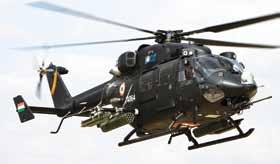
“For India, IDAS is more than just a product proposition. Having established the maintenance, transfer of technology at HAL Hyderabad, Saab is now in the final stages with HAL for IDAS production transfer of technology to India. This means HAL, will be producing the local Indian versions of IDAS right here in India,” says Group Captain Ritu Raj Tyagi (Retd), Marketing Director, Aeronautics, Saab India.
Two variants of IDAS is in operation on Dhruv. The Air Force version Integrated Self Protection Suite (ISPS) and the Army version Electronic Warfare Self Protection System (EWSPS). Both versions include radar warning, missile approach warning, laserwarning as well as the countermeasure dispensing system produced by Bharat Dynamics Limited (BDL).
IDAS is setting the standard for platform agnostic, integrated self-protection systems. More than 500 systems are already installed on various types of aircraft such as helicopters, fixed wing platforms and fighter aircraft.

Aero Ind IA 2023 WWW.SPSShoWneWS COM www.spguidepublications.com 10 | Day 3 | febraury 15, 2023 SPECIAL SToRy
(top) nh90 with saab ew; (above) alh ruDra of the iaf
CommerCial airplanes Deliveries to south asia (2022-2041) Regional Jet 0 Single Aisle 1,983 Widebody 227 Freighter 80 Total (excluding freighters) 2,210

Reaching for the skies together


Aero India, we remain dedicated to the inspiring progress of India and proudly support the nation’s focus toward becoming Aatmanirbhar in aerospace and defence.
us and help shape aerospace innovation: boeing.com/indiacareers
At
Join

































